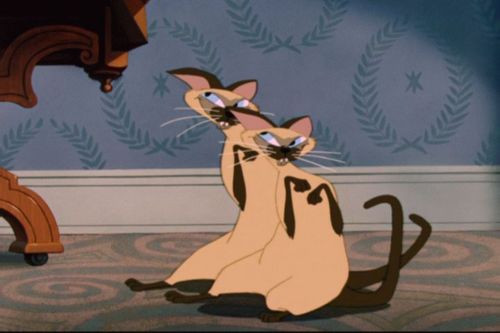“The Siamese Cat Song” from Disney’s Lady and the Tramp (1955) might be a tune you vaguely recall, or perhaps it’s a cherished favorite from childhood. This piece of music, featuring the mischievous Siamese cats Si and Am, is a memorable part of the film’s soundtrack, yet it also stirs up controversy due to its depiction of Asian stereotypes. While Lady and the Tramp itself may not be as prominent in today’s children’s movie landscape, its musical moments, especially this cat song, are still worth revisiting and analyzing.
The song introduces Si and Am, twin Siamese cats who arrive with Aunt Sarah to temporarily disrupt Lady’s pampered life. Musically, “The Siamese Cat Song” is instantly recognizable. It cleverly utilizes a pentatonic scale, a five-note musical scale often associated with East Asian music. This, coupled with the opening gong sound effect, immediately sets an “Asian” sonic landscape, relying on cultural shorthand.
However, the stereotypes become more pronounced, and problematic, when we consider the cats’ visual design and dialogue. Si and Am are drawn with exaggerated buck teeth, a feature historically used to caricature East Asian people. Their way of speaking, or rather singing, employs overly formal phrasing combined with grammatically incorrect English. The opening lines of the song exemplify this:
We are Siamese, if you please
We are Siamese if you *don’t* please
Now we lookin’ over our new domicile
If we like we stay for maybe quite a while
The formality of phrases like “if you please” contrasts sharply with the broken grammar (“lookin’”, “we stay for maybe”). This linguistic style was, unfortunately, a common and offensive trope used in mid-20th century media to depict people of Asian descent.
 Siamese cats plotting mischief in Lady and the Tramp
Siamese cats plotting mischief in Lady and the Tramp
Despite these problematic elements, the song itself is undeniably catchy and cleverly written in terms of portraying character through music. While Si and Am maintain a polite and almost singsong tone throughout their verses, their lyrics and actions are all about causing chaos. They plot to drown goldfish, contemplate stealing milk from a baby, and generally wreak havoc in the house. Consider these lines:
Do you seeing that thing swimming round and round?
Yes. Maybe we can reaching in and make it drown.
If we sneaking up upon it carefully
There will be a head for you, a tail for me.
Do you hear what I hear?
A baby cry?
Where we finding baby there be milk nearby.
If we look in baby buggy there could be
Plenty milk for you and also some for me.
This contrast between their polite singing and mischievous intent is what makes the song entertaining, even while the stereotypical portrayal is cringeworthy. In the film, their antics escalate quickly: vases are toppled, curtains shredded, and a general state of pandemonium ensues. The climax arrives when they frame Lady for the mess they created, highlighting their manipulative and cunning nature.
Looking back at “The Siamese Cat Song” today, it’s crucial to acknowledge both its musicality and its deeply embedded stereotypes. It serves as a reminder of how cultural biases were once casually woven into popular entertainment, even in beloved Disney films. While the tune might be catchy and the character animation memorable, it’s important to view “The Siamese Cat Song” with a critical lens, understanding its historical context and recognizing the harmful stereotypes it perpetuates. It’s a piece of Disney history that prompts important conversations about representation and cultural sensitivity in animation and film music.
See also:
Lady and the Tramp “Bella Notte” (1955)
Lady and the Tramp “He’s a Tramp” (1955)
For more classic Disney songs, check out the main page: Disney Films & Soundtracks A-Z
